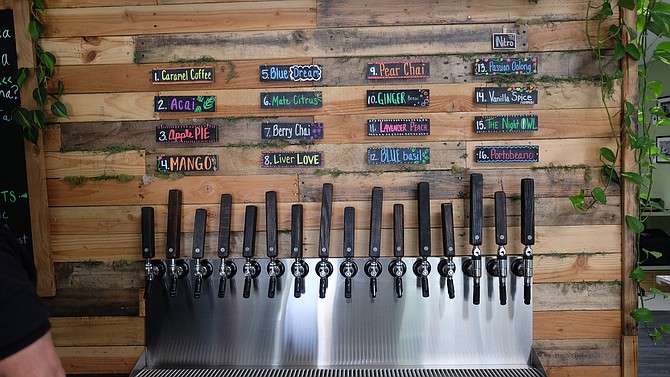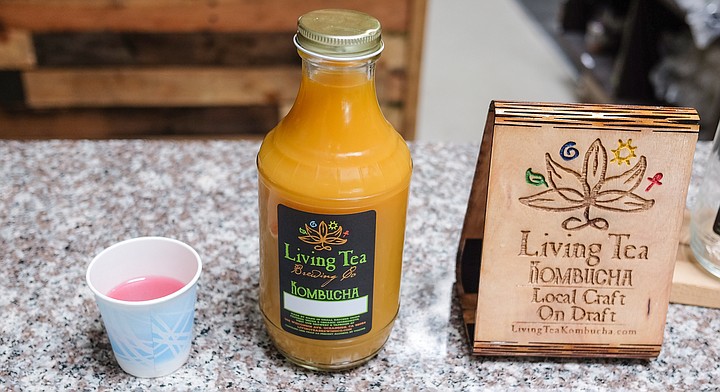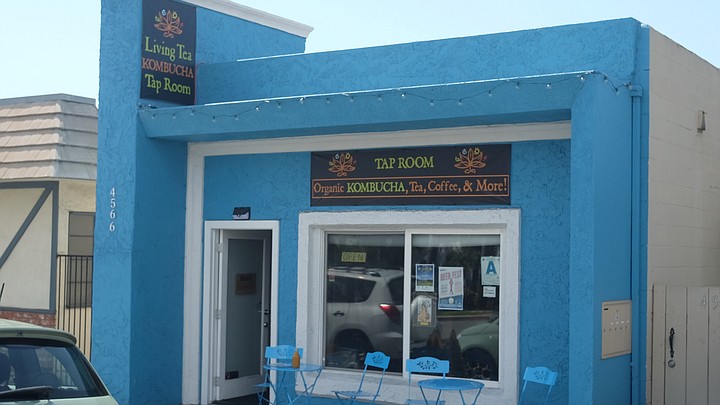 Facebook
Facebook
 X
X
 Instagram
Instagram
 TikTok
TikTok
 Youtube
Youtube

I think it’s safe to say that kombucha’s not a fringe beverage anymore. At least here in California. Once the domain of health food shops, these days I find the probiotic tea in gas stations, coffee shops, and even bars. In some parts of town you can even buy it by the growler fill, out of a dedicated tap room.
With something like that in mind, I stopped by Living Tea Tap Room a few weeks back — that’s the North Park location of the Living Tea Brewing Co., a kombucha maker in Oceanside. I got my kombucha, but I got something else in the bargain, and it does still qualify as a fringe beverage: kava.

That’s also a tea, but — and insert whatever joke you will about the oftentimes vinegary taste of kombucha here — kava is not one you drink for the flavor.
Oh, you can try. But the truth is kava tea looks like swamp water and tastes like clay. The tea is made from the ground root of the kava-kava, a leafy plant native to the south Pacific. Apparently, kava is the Tongan word meaning bitter, so if you’re out there thinking you might acquire a taste for kava, just remember its name translates to bitter, bitter.

So why drink it? Well, kava is best known for producing a mild psychoactive effect. I might describe it as a feeling of contentment, but officially what it does is relieve anxiety and treat insomnia. I can vouch for the former: after drinking it, I fully understood why some call it “liquid xanax,” or compare it to valium.
While several countries have banned kava, it’s treated as an herbal supplement by the FDA, and therefore its sale is less regulated than, say, alcohol. Back in 2002, the FDA did issue a consumer advisory citing other nations’ reports that kava had been linked 25 cases of liver toxicity, but 16 years later, most of its interest in kava has been investigating vendors to make sure their sources are legit.
Living Tea does a pretty great job making its kombucha palatable, offering over a dozen flavors including acai, ginger, and lavender peach. I particularly like the pear chai flavor.
It flavors its kava as well, coming up with a variety of masks for the bitter clay flavor. In recent weeks I’ve tried beet & ginger, apple & beet, and carrot & orange. While they both look and taste objectively better than the mud-puddle-like original, the purple and orange hued drinks taste like ginger-flavored clay, apple-flavored clay, and carrot-flavored clay, respectively. If there’s good news, it’s that the kava root also creates a numbing effect, so if you do try happen to taste it on the way down, kava tea deadens the tongue so at least you don’t suffer the aftertaste.
In any regard, if you choose to try kava, it’s best to do so as a shot, and to that end Living Tea served single ounce shots for $1.50. To fill a 16-ounce growler is $20. For an adult of average size, 2-3 ounces seems to be the recommended amount to experience its effects, and should never be taken with alcohol.
In my (limited recent) experience, it can lift you out of the stress of a bad mood. And while I can see why it could help treat insomnia, it didn’t make me sleepy. In fact, aside from the numb tongue, it didn’t dull my senses or prevent me from being productive at all. Still, I prefer the kombucha.


I think it’s safe to say that kombucha’s not a fringe beverage anymore. At least here in California. Once the domain of health food shops, these days I find the probiotic tea in gas stations, coffee shops, and even bars. In some parts of town you can even buy it by the growler fill, out of a dedicated tap room.
With something like that in mind, I stopped by Living Tea Tap Room a few weeks back — that’s the North Park location of the Living Tea Brewing Co., a kombucha maker in Oceanside. I got my kombucha, but I got something else in the bargain, and it does still qualify as a fringe beverage: kava.

That’s also a tea, but — and insert whatever joke you will about the oftentimes vinegary taste of kombucha here — kava is not one you drink for the flavor.
Oh, you can try. But the truth is kava tea looks like swamp water and tastes like clay. The tea is made from the ground root of the kava-kava, a leafy plant native to the south Pacific. Apparently, kava is the Tongan word meaning bitter, so if you’re out there thinking you might acquire a taste for kava, just remember its name translates to bitter, bitter.

So why drink it? Well, kava is best known for producing a mild psychoactive effect. I might describe it as a feeling of contentment, but officially what it does is relieve anxiety and treat insomnia. I can vouch for the former: after drinking it, I fully understood why some call it “liquid xanax,” or compare it to valium.
While several countries have banned kava, it’s treated as an herbal supplement by the FDA, and therefore its sale is less regulated than, say, alcohol. Back in 2002, the FDA did issue a consumer advisory citing other nations’ reports that kava had been linked 25 cases of liver toxicity, but 16 years later, most of its interest in kava has been investigating vendors to make sure their sources are legit.
Living Tea does a pretty great job making its kombucha palatable, offering over a dozen flavors including acai, ginger, and lavender peach. I particularly like the pear chai flavor.
It flavors its kava as well, coming up with a variety of masks for the bitter clay flavor. In recent weeks I’ve tried beet & ginger, apple & beet, and carrot & orange. While they both look and taste objectively better than the mud-puddle-like original, the purple and orange hued drinks taste like ginger-flavored clay, apple-flavored clay, and carrot-flavored clay, respectively. If there’s good news, it’s that the kava root also creates a numbing effect, so if you do try happen to taste it on the way down, kava tea deadens the tongue so at least you don’t suffer the aftertaste.
In any regard, if you choose to try kava, it’s best to do so as a shot, and to that end Living Tea served single ounce shots for $1.50. To fill a 16-ounce growler is $20. For an adult of average size, 2-3 ounces seems to be the recommended amount to experience its effects, and should never be taken with alcohol.
In my (limited recent) experience, it can lift you out of the stress of a bad mood. And while I can see why it could help treat insomnia, it didn’t make me sleepy. In fact, aside from the numb tongue, it didn’t dull my senses or prevent me from being productive at all. Still, I prefer the kombucha.
Comments